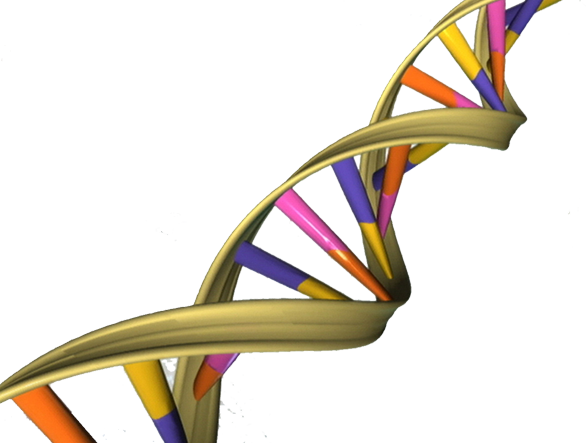 Okay, so we have asked you to think about DNA and get creative, writing a great story in under 500 words about how our understanding of DNA and genetics has had an impact on the world. But why? What’s the fuss all about? What is this amazing stuff, DNA?
Okay, so we have asked you to think about DNA and get creative, writing a great story in under 500 words about how our understanding of DNA and genetics has had an impact on the world. But why? What’s the fuss all about? What is this amazing stuff, DNA?
Firstly, it stands for DeoxyriboNucleic Acid and it’s a pretty awesome molecule. Made from 2 strands coiled together into a double helix, it has a backbone of sugars and phosphates joined together by pairs of ‘bases’ which may be adenine (A), guanine (G), cytosine (C) or thymine (T). It is the combination of just these 4 bases that are the code or set of instructions for how to make you! It is like your very own recipe for a human (or an octopus, or a meerkat, or a daisy depending on your species).
‘How can 4 simple bases be enough instructions to make the marvellous me?’ I hear you cry, ‘Surely, I am far too complex and sophisticated!’
Well actually, 4 bases are enough. You know when you go to the supermarket and the nice person at the checkout scans your shopping with the machine that goes ‘bleep’? That is the barcode telling the computer what item you have bought (and we just have to hope it isn’t the latest Justin Bieber CD!) The barcode is a short sequence which is specific to each different item in the shop. The sequence of bases in your genetic code is the same – short sequences of these bases are specific to different building blocks (called amino acids). Depending on which amino acids are made and in what combination, they are joined together to make different proteins – and proteins, are what you need to build a person (or a meerkat, or Justin Bieber, you get the picture!)
The other clever thing is that you get the combination of bases from your parents in the form of genes (1 gene is enough to make 1 protein). This means you end up looking a bit like them and having similar characteristics. This includes things like your eye colour, your blood-type and your face shape. It can also mean you inherit problems or mistakes in the genes a bit like a mis-spelling in the code and this can cause genetic diseases like muscular dystrophy or cystic fibrosis.
 Because we now know quite a bit about the codes that make up genes, scientists are able to work out more about how some of these diseases are caused and how they might be treated – it is all exciting stuff and there is lots happening in the field of genetics (the study of DNA and genes). Maybe you might even be one of the scientists of the future who will be working on this!
Because we now know quite a bit about the codes that make up genes, scientists are able to work out more about how some of these diseases are caused and how they might be treated – it is all exciting stuff and there is lots happening in the field of genetics (the study of DNA and genes). Maybe you might even be one of the scientists of the future who will be working on this!
Our knowledge of DNA and this area of science also affects and influences many other areas of everyday life. Crimes that were committed many years ago are now being solved as DNA from old evidence may hold clues to identify the person responsible. DNA can also be helpful in tracing your ancestors, to find out who they were and where they lived.
This is however, only the tip of the iceberg and the implications of what we are now discovering will change the future for all of us.
This is where you come in – for this competition, let your imagination run free, have crazy ideas and enjoy yourself. Explore stories and ideas raised by the discovery of DNA and the science of genetics.
You might want to think about how unlocking the genetic code may affect your family, friends and the society around you. Will it ever be the same again? Will information always be used for good? What happens if it falls in to the ‘wrong hands’? Would you want to be tested to see what diseases you might get in the future?
Might we be able to create ‘super-plants’ or ‘designer-animals’ that are free from disease?
What must it have been like being the scientists like Watson and Crick, who made amazing discoveries?
You can find lots more about DNA, genes and the scientists who made important discoveries from your teachers (go and ask them lots of tricky questions – they love that!) and from the library or the internet.
Here are a few links to get you started:
http://www.bbc.co.uk/schools/gcsebitesize/science/edexcel_pre_2011/genes/dnarev1.shtml
http://www.nobelprize.org/educational/medicine/dna_double_helix/readmore.html
http://www.exploreforensics.co.uk/what-is-DNA.html
http://www.bbc.co.uk/history/historic_figures/watson_and_crick.shtml

